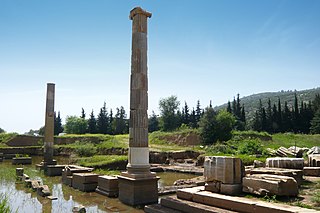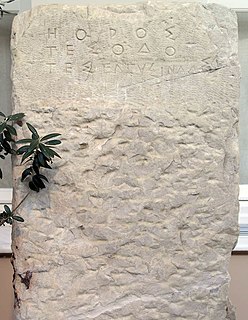
Croesus was the king of Lydia who, according to Herodotus, reigned for 14 years: from 560 BC until his defeat by the Persian king Cyrus the Great in 546 BC.

In Greek mythology, King Laius, or Laios of Thebes was a key personage in the Theban founding myth.

The sibyls were oracles in Ancient Greece. The earliest sibyls, according to legend, prophesied at holy sites. Their prophecies were influenced by divine inspiration from a deity; originally at Delphi and Pessinos, the deities were chthonic deities. In Late Antiquity, various writers attested to the existence of sibyls in Greece, Italy, the Levant, and Asia Minor.

A sacrificial tripod is a three-legged piece of religious furniture used for offerings or other ritual procedures. As a seat or stand, the tripod is the most stable furniture construction for uneven ground, hence its use is universal and ancient. It is particularly associated with Apollo and the Delphic oracle in ancient Greece, and the word "tripod" comes from the Greek meaning "three-footed".

In Greek mythology, Perseus is the legendary founder of Mycenae and of the Perseid dynasty. He beheaded the Gorgon Medusa for Polydectes and saved Andromeda from the sea monster Cetus. He was the son of Zeus and the mortal Danaë, as well as the half-brother and great-grandfather of Heracles.

The Delphic Sibyl was a woman from before the Trojan Wars mentioned by Pausanias writing in the 2nd century AD about stories he had heard locally. The Sibyl would have predated the real Pythia, the oracle and priestess of Apollo, originating from around the 8th century BC.

Metapontum or Metapontium was an important city of Magna Graecia, situated on the gulf of Tarentum, between the river Bradanus and the Casuentus. It was distant about 20 km from Heraclea and 40 from Tarentum. The ruins of Metapontum are located in the frazione of Metaponto, in the comune of Bernalda, in the Province of Matera, Basilicata region, Italy.

Claros was an ancient Greek sanctuary on the coast of Ionia. It contained a temple and oracle of Apollo, honored here as Apollo Clarius. It was located on the territory of Colophon, one of the twelve Ionic cities, twelve kilometers to the north. The coastal city Notion lay two kilometers to the south. The ruins of the sanctuary are now found north of the modern town Ahmetbeyli in the Menderes district of Izmir Province, Turkey.

The Serpent Column, also known as the Serpentine Column, Plataean Tripod or Delphi Tripod, is an ancient bronze column at the Hippodrome of Constantinople in what is now Istanbul, Turkey. It is part of an ancient Greek sacrificial tripod, originally in Delphi and relocated to Constantinople by Constantine the Great in 324. It was built to commemorate the Greeks who fought and defeated the Persian Empire at the Battle of Plataea. The serpent heads of the 8-metre (26 ft) high column remained intact until the end of the 17th century.

The Athenian Treasury at Delphi was constructed by the Athenians to house dedications and votive offerings made by their city and citizens to the sanctuary of Apollo. The entire treasury including its sculptural decoration is built of Parian marble. The date of construction is disputed, and scholarly opinions range from 510 to 480 BCE. It is located directly below the Temple of Apollo along the Sacred Way for all visitors to view the Athenian treasury on the way up to the sanctuary.

Xenoclea, who appears as a character in the legend of Hercules, was the Pythia, or priestess and oracle, of the temple of Apollo at Delphi.
Among the famous ex votos of Delphi was that of Craterus, friend and general of Alexander the Great, attributed to Lysippus.
The tenth book of the work Description of Greece by the traveler Pausanias is dedicated to Phocis; its larger part constitutes a description of the sanctuaries and buildings of Delphi. His work constituted a precious aid to travelers and archaeologists who attempted to identify the monuments revealed by the excavations, although in some cases their identifications were not enough.
After the naval Battle of Aegospotami, the Lacedaemonians dedicated a majestic ex voto in Delphi.
One of the most famous ex votos in the sanctuary of Apollo in Delphi was the bronze bull dedicated by the citizens of Corfu in remembrance of a remarkable tuna fish catch.
Next to the Bull of the Corcyreans close to the entrance to the sanctuary of Apollo in Delphi lay a grandiose monument dedicated by the Arcadians, particularly the Tegeates.
The city of Argos dedicated several ex votos within the sanctuary of Apollo in Delphi. It was, after all, one of the most powerful cities of the archaic and classical period.
















